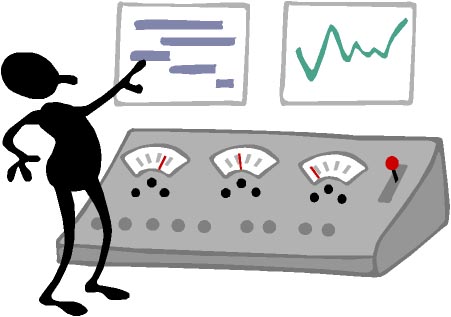Source: Tom McIntyre, Virginia Tong, and Ellis Barowsky (In
press). Do We Have the TechKNOWLEDGEgy? An irreverent look at the use of
technology in managing behavior.
Technology and Behavior
The tone sounded, indicating that
I (Tom) had a new e-mail message. It was from a professional list-serve
and announced that a certain institution of higher education was searching
for someone with "expertise in behavior disorders and technology".
I summoned two nearby colleagues and asked them: Did this phrasology mean
that they wanted someone trained in behavior disorders who also happened
to be a techno-geek? Or did they desire someone familiar with electronic
interventions for youngsters who display inappropriate behaviors?
If the second possibility was the case, what knowledge would candidates
for the position of "EBD techno-prof" possess? With what devices
would they be familiar? Only one of us (Virginia) has any knowledge
and capability in the use of technology in the classroom, but her training
is in the areas of ESL and linguistics. Ellis and I have training
in behavior disorders, but the highest technology item we ever used in
the public school classroom was a mechanical pencil.
In our travels to visit practica students, we've watched youngsters
unload from school buses equipped with video cameras that record on-the-road
behavior previous to passing through their school's state-of-the-art metal
detectors and x-ray machines. These technological gateways, used
to search New York City youngsters and their belongings, are the last high-tech
devices that many youngsters see as they pass into the electronic desert
of their decaying schools. But how else, we asked each other, might
(post)modern technological marvels be used in schools and classrooms when
students show us their fun-house mirror versions of appropriate behavior?
We brainstormed for a while, having great fun conceptualizing electronic
interventions that might be used when a youngster's behavior grates on
the teacher's last good nerve like #6 sandpaper. Like we tell many
of our teachers though, we had to remind ourselves to focus on promoting
positive behavior too, not just penalizing inappropriate actions.
We've listed a number of imagined interventions that emanated from our
temporarily giggled grey matter. We recommend that they be read in
the style of the "top 10" lists popular on late night television.
The Top 18 Ways to Prevent and
Manage Inappropriate Behaviors
~Require pupils to wear FM unit headphones over which
we play elevator musak (although this music might be considered by some
people to be cruel and unusual punishment) laced with subliminal messages
stating such phrases as "Stay in your seat.", " Speak politely to others.",
and "Complete your work now." Teachers could break in periodically
to deliver louder messages intended to direct youngsters' actions.
~Play a non-stop videotape of well-behaved kids on several
televisions placed strategically around the room in order to provide errant
youngsters with positive role models.
~Require kids to wear proximity alarms to remind them to stay
a prescribed distance away from each other. If they approach another
too closely, an electronic voice, similar to those installed in luxury
cars bellows "Warning. You are too close. Back away from the
classmate." while a blaring, warbling siren wails in the background.
The intensity of the stimuli would be faded over time.
~Hook up blood pressure cuffs and heart rate monitors to our
more aggressive students in order to warn us of when they are reaching
their "threshold of action".
~Have youngsters wear those behind-the-ear devices (the ones
used by drowsy drivers to stay awake) that send out a piercing tone when
the head tilts down. This mechanism would keep students awake in
classrooms where teachers think that "individualization of instruction"
means giving youngsters different piles of worksheets.
~Distribute uni-directional "sonic ear" microphones to teachers
so that they can hear what their pupils are whispering to each other in
the back row.
~Use "clapper" devises to pause and restart desk mounted machines
that automatically disseminate tokens/M&Ms/tickets while robotically
praising youngsters for their good behavior.
~Set up hidden video cameras to stream video images to the computer
of an instructor who is home sick. That instructor could then speak
into a microphone connected to the substitute teacher's earpiece, providing
directions as to how to handle the various situations. Supervising
teachers could use this set-up to guide their student teachers from the
comfy confines of the teachers' lounge.
~e-mail behavior consultants for advice while youngsters
are still in the midst of their behavioral episodes.  Perhaps
each function key on the keyboard could be assigned a category of misbehavior
in order to save time in communicating the problem to the expert.
This innovative venue would open up a lucrative new way for consultants
to make money while sipping coffee at home.
Perhaps
each function key on the keyboard could be assigned a category of misbehavior
in order to save time in communicating the problem to the expert.
This innovative venue would open up a lucrative new way for consultants
to make money while sipping coffee at home.
~Use cellular phones to call a student's home as soon as that
step in the hierarchy of disciplinary consequences is reached. Now
teachers no longer have to wait until after school to undertake this decades-old
feared consequence. They can go immediately to their purse or briefcase,
pull out their little tele-communicators and press one of the automatic
dial buttons...each one of which is set to a different student's home phone
number. When youngsters plead for mercy, teachers can leave their
finger poised over the "send" button, using the Dr. Strangelovian approach
of threatening to push the button if any further infractions occur.
We assume that teachers would also add significantly to their phone bills
by calling parents to report effort and improvement on the part of their
students.
~Take Polaroid photos (Are these cameras still considered to
be high tech?) of misbehaving pupils and faxing them to their parents'
office. We would also hope that teachers would take lots of photos
of youngsters engaged in appropriate actions.
~Wear "fedora cams" (video cameras hidden in hats...similar to
those used by investigative news teams) to send continuous stream of images
of the offending behavior to the parent's computer. A digital image
enhancer would highlight the offending behavior or gesture. Again,
we'll need to remember to send home images of youngsters "doing the right
thing".
~Send behavioral reports home via e-mail during planning periods
or before leaving the school for the day. Teachers would warn parents
to keep their password private or install fingerprint identification peripherals
so that their children don't "hack in" and delete the messages...We wouldn't
want students to engage in the high tech equivalent of running home to
check the mail for school notices before mom and dad get there. We're
confident that teachers would remember to send home positive messages too.
~Use the video option on in-school computer networks so that
principals can be summoned by substitute teachers to come on screen to
chastise kids whenever needed. Perhaps some classroom computers could
be connected to the homes of ill teachers so that they could continue to
monitor and direct the actions of their youngsters. However, for
those of us who never used a sick day unless we were well enough to enjoy
it, the possibility of being "found out" is a definite drawback.
We think that we may have found a solution for this problem...claiming
to be too haggard-looking to have ourselves placed on screen and sending
only an audio signal, or perhaps posting a stern looking photograph.
Satellite connected notebook computers would then allow us to view our
students and respond to them while stretched out on the beach blanket ("Miguel,
dos margarita por favor."). Being immersed in our favorite environments
should also make it easier for teachers to recognize and respond to prosocial
student behavior.
~Install motion sensors to alert teachers when kids get out of
their seats, and laser beam perimeter alarms to keep them from sneaking
out of the room when teachers aren't looking. If youngsters do leave
the area, bar coded UPC stickers attached to shirt sleeves would allow
educators to determine who exited. Meanwhile, other sensors in the
hallways would cause little red bulbs to light up on the main office's
map of the school's interior, informing school personnel of escapees' locations.
~(If the bar code scenario is not possible) Have main office
secretaries compare stilled images from hallway video cameras to the collected
pictorial images in their school enrollment data bank. This process
would be similar to scenes in the "Mission Impossible" and "Enemy of the
State" movies when the picture collection rapidly flashes by on the screen
until a match is found, displaying that youngster's personal data.
~Create a virtual reality program during which goggled youngsters
display recently practiced socially appropriate behavior when they are
asked to join a group of ne'er-do-wells, confronted by caustic-natured
teachers/administrators, or lured into bullying behavior by the mere sight
of computer generated nerd.
~Place electronic weather stations in teachers' lounges to monitor,
record, and predict changing conditions  and the phases of the moon.
and the phases of the moon.  These units would ensure that educators know when to use each of the ages-old
meteorological excuses for behavioral blowups on the part of students.
These units would ensure that educators know when to use each of the ages-old
meteorological excuses for behavioral blowups on the part of students.
The Bug That Never Stung
While Virginia is well-situated for the technological future,
Ellis and I had hoped that the Y2K bug would hit, shutting down computerized
digital devices and the internet so that we would no longer be viewed as
technical neanderthals. Having stockpiled back issues of professional
journals from past decades alongside our food and water stores, we thought
we might once again be on the cutting edge of our field. Now we analog
types who are stuck in today's digital society must attempt to walk upright
in cyberspace.
We admit to not having a great deal of familiarity with all the
new high tech gizmos, so perhaps we'll need to venture outside of the local
publicly funded schools and colleges of New York City to directly observe
how universities and schoolhouses with money to purchase technology actually
make use of it. Then we'd be better able to train our teachers for
the hypothetical day when they get high-tech equipment and can create classrooms
teeming with compliant, respectful "teachers' pets". But first we
dream of the day when our New York City teachers will be working in buildings
where ceilings don't leak, plaster doesn't fall, paint doesn't peel, and
the coal-fired furnaces are replaced by newer units capable of conducting
heat to the upper floors on cold winter days. Our teachers and kids
could also make use of textbooks that have been printed within the last
20 years, decades old paper that doesn't crumble when youngsters try to
write on it, and...Oops, gotta go. Just got a call on my new cellular
phone (I got a great deal on the model with the rotary dial option).
Hello. Big Brother Consultants. How can we help you?
Can we can conduct a staff development workshop on educational technology?
You bet!

This puppy is kept safe inside designated boundaries by a sonic fence
device.
 Perhaps
each function key on the keyboard could be assigned a category of misbehavior
in order to save time in communicating the problem to the expert.
This innovative venue would open up a lucrative new way for consultants
to make money while sipping coffee at home.
Perhaps
each function key on the keyboard could be assigned a category of misbehavior
in order to save time in communicating the problem to the expert.
This innovative venue would open up a lucrative new way for consultants
to make money while sipping coffee at home.

 and the phases of the moon.
and the phases of the moon.  These units would ensure that educators know when to use each of the ages-old
meteorological excuses for behavioral blowups on the part of students.
These units would ensure that educators know when to use each of the ages-old
meteorological excuses for behavioral blowups on the part of students.